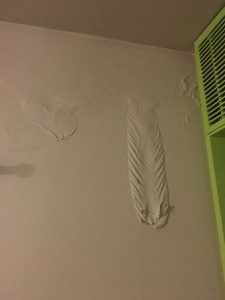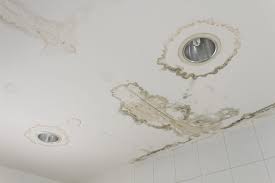When we think of water damage, often we think of floods or a burst pipe that results in inches on water on the floor. However, many times the slow leak of a pipe can cause more damage. Because it can go unnoticed for a long period of time, the slow leak can create mold or rot and destroy building material that would be able to be saved and dried.
In the summer months cold water pipes will turn humidity into condensate and the pipes will “sweat“. This can cause some damage but usually it is minor and limited to staining. Once the humidity decreases the moisture will evaporate so mold will have a hard time establishing itself.
Far more damaging is a pinhole leak or a broken fitting. That situation will cause moisture to be present in enough quantity and for long enough to do real damage.
THINGS TO LOOK FOR:
 Bubbling Paint – Water can slowly seep through drywall or come in through the seams where it meets the ceiling. If you see this situation, you will tend to have a much larger problem on the inside of the wall. The source of water will continue to damage the framing and destroy the effectiveness of the insulation. Most like there will also be mold as well.
Bubbling Paint – Water can slowly seep through drywall or come in through the seams where it meets the ceiling. If you see this situation, you will tend to have a much larger problem on the inside of the wall. The source of water will continue to damage the framing and destroy the effectiveness of the insulation. Most like there will also be mold as well.
 Water Stains on Ceilings – A slow leak will spread water in six different directions: back and forth, side to side and up and down. Many times water will find a path of least resistance on fixtures such as lights or speakers, cross beams, and the tape seems between panels of drywall. When it gets to this point, the cause typically isn’t sweating pipes. That moisture has already made the journey from the source which can be a fair distance away. A larger area like that will have enough moisture where mold will be an issue. Mold needs warmth and it can find it more easily in ceilings than in exterior walls. Also recessed lighting creates heat.
Water Stains on Ceilings – A slow leak will spread water in six different directions: back and forth, side to side and up and down. Many times water will find a path of least resistance on fixtures such as lights or speakers, cross beams, and the tape seems between panels of drywall. When it gets to this point, the cause typically isn’t sweating pipes. That moisture has already made the journey from the source which can be a fair distance away. A larger area like that will have enough moisture where mold will be an issue. Mold needs warmth and it can find it more easily in ceilings than in exterior walls. Also recessed lighting creates heat.
Unexplained Surface Mold – Mold can make its way through dry wall. Also if dry wall stays wet from a source on the inside of the wall, exterior mold can form. These small patches are typically not a problem to manage and many home owners will treat them with bleach. However, those spots are just symptoms of a much larger issue that exists inside the wall. It is typically best to remove that drywall, fix the source and treat the mold.
If you need a moisture evaluation please call ServiceMaster Fire & Water Restoration. We work with virtually every insurance company. It is advisable to have these issues addressed as soon as possible.
We cover Greater Portland, Brunswick, Bath, Augusta, Waterville, Lewiston, Auburn, Oxford, Bridgton, Norway, Bethel, and Rumford areas.

